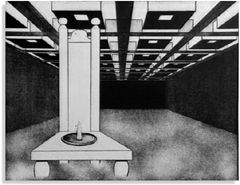| Ragnheidur Jónsdóttir |
 |
 |
|
|
by Adalsteinn Ingólfsson
Graphic art has been very much one of the focal points of artistic life in this country during the last few years. It has been demonstrated that there exists a distinctively Icelandic tradition in this form of art, that Icelandic artists are qualified to take part in international exhibitions - and, last but not least, that great public interest in graphics has been created. The Graphics Group should seize the opportunity and make use of this interest, put up a workshop and extend their activities. Therefore it is regrettable that there is still no sign of the graphic folders the Group promised the public at their general exhibition at Kjarvalsstadir last summer and that no thought has been given to the common work facilities of graphic artists.
If Icelandic graphic art was quite up to standard, then Ragnheidur Jónsdóttir’s exhibition showed that it has come of age and that it stands comparison with the best other countries have to offer.
A respectable View of Life
Ragnheidur’s contribution is all the more remarkable for the fact that it was only in 1968 or thereabout that she started her work in graphics. In this short period she has fully mastered the difficult technique of etching and aquatint and exploited it in the service of a respectable view of life and ad proper picture language. Ragneidur exhibited 43 pieces, all etchings and aquatints with a few coulour prints and one drypoint, the layout of the exhibition being particularly attractive. Besides, the exhibition catalogue was well made.
Ragnheidur’s earliest pictures indeed reveal remarkable security. These are powerful line drawings where bunches of lines are shattered from a given picture core, but one year later the artist feels a need to occupy herself with clearly delineated feeling of space makes its appearance. A consequence of this is ad picture like ‘At the corner’, where we see her first organic ‘bellies’, finely shaded and soft.
On Seclusion
A little later she starts to work with colour tones with good results and perhaps it is in these colour pieces that a harmonization of hands and mind is first to be seen. They typically show seclusion, isolation or some kind of helplessness in living things - organic debris struggling squeezed within a closed space.
Support is lent to my interpretation by the names chosen by Ragnheidur for her pictures during the following years: ‘The human cage’, ‘Stop the world’, ‘Memorials’, etc. - and in her latest works a more clearly defined social attitude and sympathy with a broader class is revealed - with women’s lib and against robotism and demagogy. However, Ragnheidur’s works are not ‘covered’ with slogans; rather, her pictorial thinking is based on the opposition between the living and intimate, on the one hand, and the mechanical and institutionalized, on the other. One of the best examples of this approach can be found in the pictures labelled by the artist ‘2001’, ‘2002’, etc. - perhaps an allusion to Kubrick futuristic film. In these pictures convex and grape-cluster like forms hang or droop over stone banks, over angular forms or over an empty ground, full of life and sincere eroticism. Ragnheidur’s ‘pillow-pictures’ also fall into this group, curiously effective and memorable works. Then her ‘Glundur’ pictures are a more trenchant satire upon the oppresive interior of one of Reykjavík’s main exhibition halls.
Powerful Form
Ragnheidur thus knows how to express her views in a simple and eloquent form which also meets all demands as to artistic structure. A good example of this is to be found in her ‘dress-pictures’, which recently won an award at an international graphics exhibition. In these, pregnant dresses can be seen hanging for drying or spread over chairs. In her very latest pictures Ragnheidur plays with the idea of a window curtains, where she seems to be concerned with form and finish rather than a wider social subject. I find these works hardly as convincing as the earlier ones, there is a lack of identity and occasional insecurity in the drawing.
However, this was the single fault in a particularly integrated and high quality exhibition and I am sure that I am not alone in waiting impatiently for Ragnheidur Jónsdóttir’s future exhibitions.
Published in Dagbladid 21 October 1976.
 |
|
|
 |
|
|
 |
|
|
|
|
|
|
|
|
|
|